A Comprehensive Literature Review: Animal Experimentation in Research
VerifiedAdded on 2022/10/01
|8
|2095
|370
Literature Review
AI Summary
This literature review examines the ongoing debate surrounding animal experimentation in medical research, weighing its benefits and drawbacks. It analyzes various peer-reviewed articles, focusing on the history of animal testing, its role in medical advancements, and the ethical considerations involved. The review discusses the limitations of animal models in replicating human physiology and diseases, particularly in cancer research, and explores alternative methods such as computer simulations and the use of zebrafish embryos. While acknowledging the contributions of animal testing to biomedical research and its potential for cost-effectiveness and reduced ethical challenges compared to clinical trials, the review also highlights concerns about animal welfare, the toxicity of experiments, and the genetic and physiological differences between animals and humans. Ultimately, the review suggests that animal testing should be conducted judiciously, adhering to strict guidelines to minimize harm to animals, and alongside the continued development of alternative research approaches. Desklib offers more resources for students seeking solved assignments and past papers.

Running head: Nursing 1
Nursing
by
Course:
Tutor:
University:
Department:
Date:
Nursing
by
Course:
Tutor:
University:
Department:
Date:
Paraphrase This Document
Need a fresh take? Get an instant paraphrase of this document with our AI Paraphraser
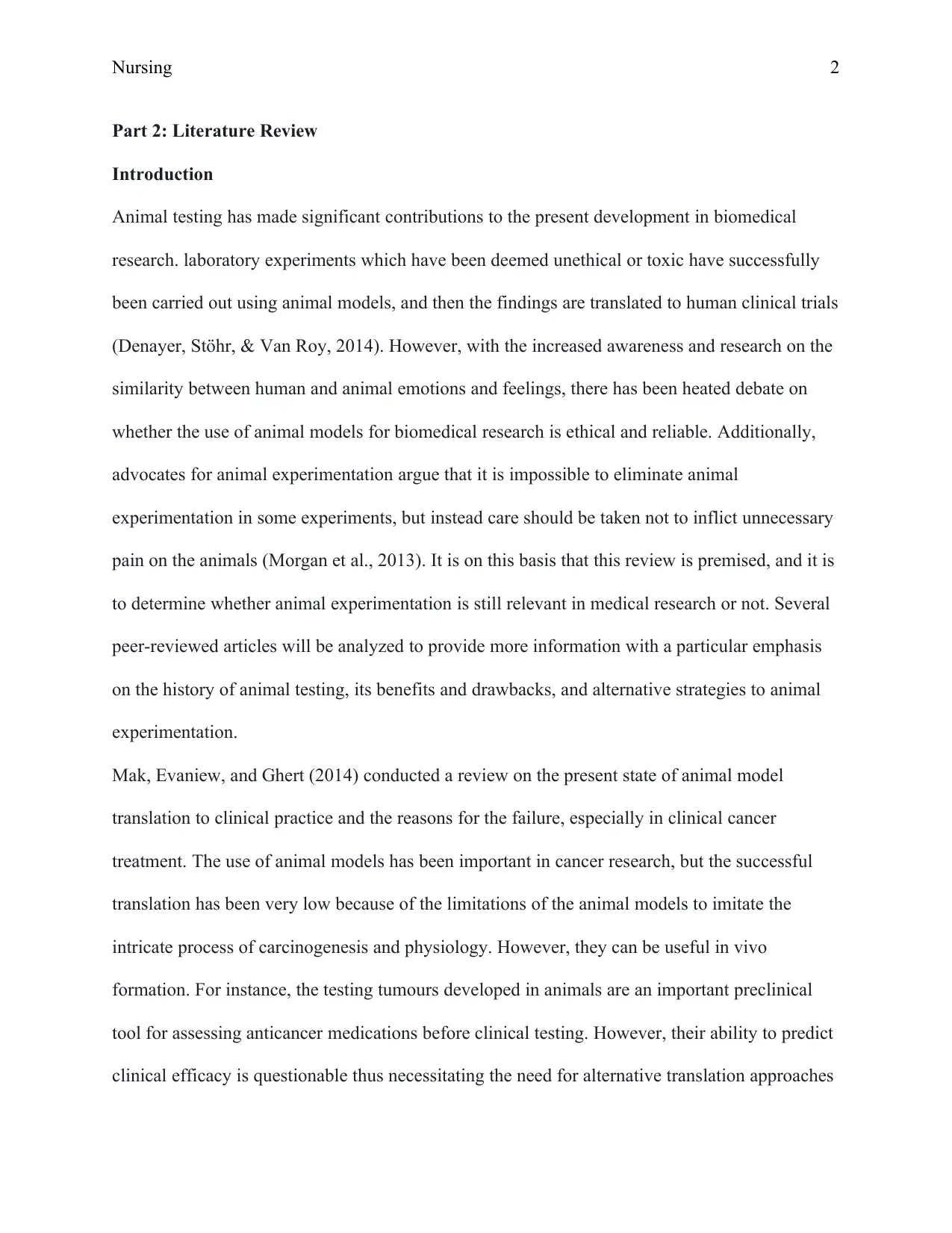
Nursing 2
Part 2: Literature Review
Introduction
Animal testing has made significant contributions to the present development in biomedical
research. laboratory experiments which have been deemed unethical or toxic have successfully
been carried out using animal models, and then the findings are translated to human clinical trials
(Denayer, Stöhr, & Van Roy, 2014). However, with the increased awareness and research on the
similarity between human and animal emotions and feelings, there has been heated debate on
whether the use of animal models for biomedical research is ethical and reliable. Additionally,
advocates for animal experimentation argue that it is impossible to eliminate animal
experimentation in some experiments, but instead care should be taken not to inflict unnecessary
pain on the animals (Morgan et al., 2013). It is on this basis that this review is premised, and it is
to determine whether animal experimentation is still relevant in medical research or not. Several
peer-reviewed articles will be analyzed to provide more information with a particular emphasis
on the history of animal testing, its benefits and drawbacks, and alternative strategies to animal
experimentation.
Mak, Evaniew, and Ghert (2014) conducted a review on the present state of animal model
translation to clinical practice and the reasons for the failure, especially in clinical cancer
treatment. The use of animal models has been important in cancer research, but the successful
translation has been very low because of the limitations of the animal models to imitate the
intricate process of carcinogenesis and physiology. However, they can be useful in vivo
formation. For instance, the testing tumours developed in animals are an important preclinical
tool for assessing anticancer medications before clinical testing. However, their ability to predict
clinical efficacy is questionable thus necessitating the need for alternative translation approaches
Part 2: Literature Review
Introduction
Animal testing has made significant contributions to the present development in biomedical
research. laboratory experiments which have been deemed unethical or toxic have successfully
been carried out using animal models, and then the findings are translated to human clinical trials
(Denayer, Stöhr, & Van Roy, 2014). However, with the increased awareness and research on the
similarity between human and animal emotions and feelings, there has been heated debate on
whether the use of animal models for biomedical research is ethical and reliable. Additionally,
advocates for animal experimentation argue that it is impossible to eliminate animal
experimentation in some experiments, but instead care should be taken not to inflict unnecessary
pain on the animals (Morgan et al., 2013). It is on this basis that this review is premised, and it is
to determine whether animal experimentation is still relevant in medical research or not. Several
peer-reviewed articles will be analyzed to provide more information with a particular emphasis
on the history of animal testing, its benefits and drawbacks, and alternative strategies to animal
experimentation.
Mak, Evaniew, and Ghert (2014) conducted a review on the present state of animal model
translation to clinical practice and the reasons for the failure, especially in clinical cancer
treatment. The use of animal models has been important in cancer research, but the successful
translation has been very low because of the limitations of the animal models to imitate the
intricate process of carcinogenesis and physiology. However, they can be useful in vivo
formation. For instance, the testing tumours developed in animals are an important preclinical
tool for assessing anticancer medications before clinical testing. However, their ability to predict
clinical efficacy is questionable thus necessitating the need for alternative translation approaches
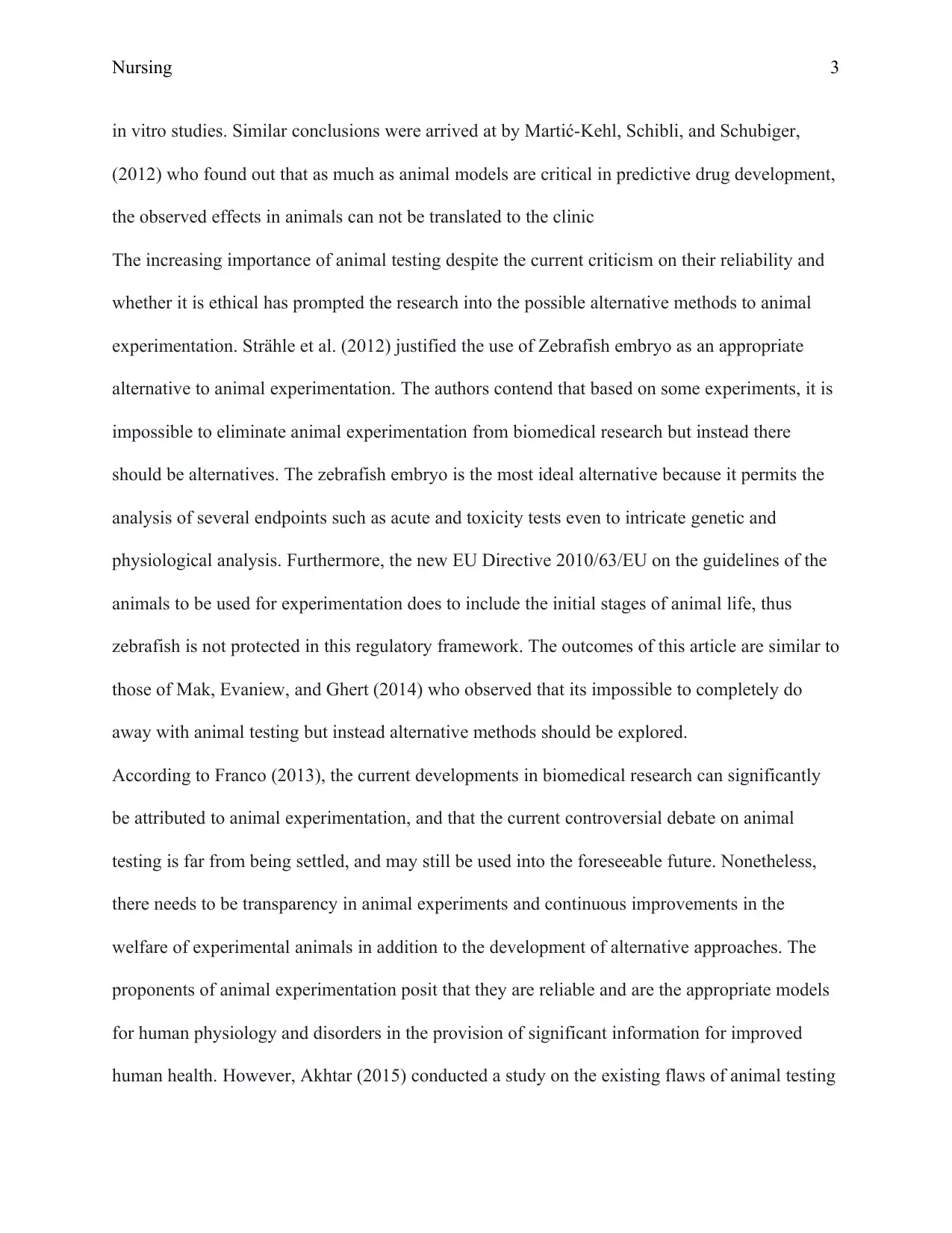
Nursing 3
in vitro studies. Similar conclusions were arrived at by Martić-Kehl, Schibli, and Schubiger,
(2012) who found out that as much as animal models are critical in predictive drug development,
the observed effects in animals can not be translated to the clinic
The increasing importance of animal testing despite the current criticism on their reliability and
whether it is ethical has prompted the research into the possible alternative methods to animal
experimentation. Strähle et al. (2012) justified the use of Zebrafish embryo as an appropriate
alternative to animal experimentation. The authors contend that based on some experiments, it is
impossible to eliminate animal experimentation from biomedical research but instead there
should be alternatives. The zebrafish embryo is the most ideal alternative because it permits the
analysis of several endpoints such as acute and toxicity tests even to intricate genetic and
physiological analysis. Furthermore, the new EU Directive 2010/63/EU on the guidelines of the
animals to be used for experimentation does to include the initial stages of animal life, thus
zebrafish is not protected in this regulatory framework. The outcomes of this article are similar to
those of Mak, Evaniew, and Ghert (2014) who observed that its impossible to completely do
away with animal testing but instead alternative methods should be explored.
According to Franco (2013), the current developments in biomedical research can significantly
be attributed to animal experimentation, and that the current controversial debate on animal
testing is far from being settled, and may still be used into the foreseeable future. Nonetheless,
there needs to be transparency in animal experiments and continuous improvements in the
welfare of experimental animals in addition to the development of alternative approaches. The
proponents of animal experimentation posit that they are reliable and are the appropriate models
for human physiology and disorders in the provision of significant information for improved
human health. However, Akhtar (2015) conducted a study on the existing flaws of animal testing
in vitro studies. Similar conclusions were arrived at by Martić-Kehl, Schibli, and Schubiger,
(2012) who found out that as much as animal models are critical in predictive drug development,
the observed effects in animals can not be translated to the clinic
The increasing importance of animal testing despite the current criticism on their reliability and
whether it is ethical has prompted the research into the possible alternative methods to animal
experimentation. Strähle et al. (2012) justified the use of Zebrafish embryo as an appropriate
alternative to animal experimentation. The authors contend that based on some experiments, it is
impossible to eliminate animal experimentation from biomedical research but instead there
should be alternatives. The zebrafish embryo is the most ideal alternative because it permits the
analysis of several endpoints such as acute and toxicity tests even to intricate genetic and
physiological analysis. Furthermore, the new EU Directive 2010/63/EU on the guidelines of the
animals to be used for experimentation does to include the initial stages of animal life, thus
zebrafish is not protected in this regulatory framework. The outcomes of this article are similar to
those of Mak, Evaniew, and Ghert (2014) who observed that its impossible to completely do
away with animal testing but instead alternative methods should be explored.
According to Franco (2013), the current developments in biomedical research can significantly
be attributed to animal experimentation, and that the current controversial debate on animal
testing is far from being settled, and may still be used into the foreseeable future. Nonetheless,
there needs to be transparency in animal experiments and continuous improvements in the
welfare of experimental animals in addition to the development of alternative approaches. The
proponents of animal experimentation posit that they are reliable and are the appropriate models
for human physiology and disorders in the provision of significant information for improved
human health. However, Akhtar (2015) conducted a study on the existing flaws of animal testing
⊘ This is a preview!⊘
Do you want full access?
Subscribe today to unlock all pages.

Trusted by 1+ million students worldwide
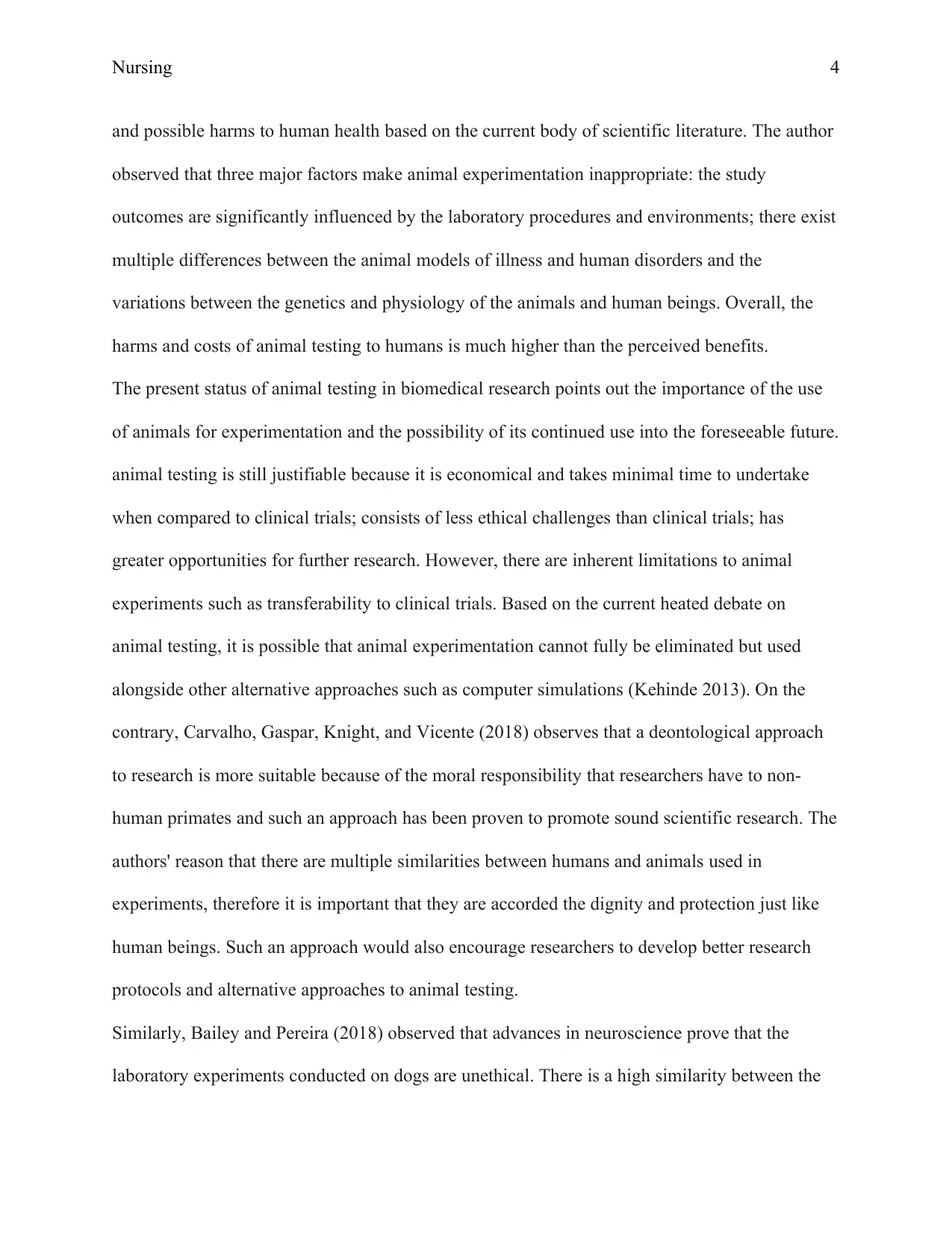
Nursing 4
and possible harms to human health based on the current body of scientific literature. The author
observed that three major factors make animal experimentation inappropriate: the study
outcomes are significantly influenced by the laboratory procedures and environments; there exist
multiple differences between the animal models of illness and human disorders and the
variations between the genetics and physiology of the animals and human beings. Overall, the
harms and costs of animal testing to humans is much higher than the perceived benefits.
The present status of animal testing in biomedical research points out the importance of the use
of animals for experimentation and the possibility of its continued use into the foreseeable future.
animal testing is still justifiable because it is economical and takes minimal time to undertake
when compared to clinical trials; consists of less ethical challenges than clinical trials; has
greater opportunities for further research. However, there are inherent limitations to animal
experiments such as transferability to clinical trials. Based on the current heated debate on
animal testing, it is possible that animal experimentation cannot fully be eliminated but used
alongside other alternative approaches such as computer simulations (Kehinde 2013). On the
contrary, Carvalho, Gaspar, Knight, and Vicente (2018) observes that a deontological approach
to research is more suitable because of the moral responsibility that researchers have to non-
human primates and such an approach has been proven to promote sound scientific research. The
authors' reason that there are multiple similarities between humans and animals used in
experiments, therefore it is important that they are accorded the dignity and protection just like
human beings. Such an approach would also encourage researchers to develop better research
protocols and alternative approaches to animal testing.
Similarly, Bailey and Pereira (2018) observed that advances in neuroscience prove that the
laboratory experiments conducted on dogs are unethical. There is a high similarity between the
and possible harms to human health based on the current body of scientific literature. The author
observed that three major factors make animal experimentation inappropriate: the study
outcomes are significantly influenced by the laboratory procedures and environments; there exist
multiple differences between the animal models of illness and human disorders and the
variations between the genetics and physiology of the animals and human beings. Overall, the
harms and costs of animal testing to humans is much higher than the perceived benefits.
The present status of animal testing in biomedical research points out the importance of the use
of animals for experimentation and the possibility of its continued use into the foreseeable future.
animal testing is still justifiable because it is economical and takes minimal time to undertake
when compared to clinical trials; consists of less ethical challenges than clinical trials; has
greater opportunities for further research. However, there are inherent limitations to animal
experiments such as transferability to clinical trials. Based on the current heated debate on
animal testing, it is possible that animal experimentation cannot fully be eliminated but used
alongside other alternative approaches such as computer simulations (Kehinde 2013). On the
contrary, Carvalho, Gaspar, Knight, and Vicente (2018) observes that a deontological approach
to research is more suitable because of the moral responsibility that researchers have to non-
human primates and such an approach has been proven to promote sound scientific research. The
authors' reason that there are multiple similarities between humans and animals used in
experiments, therefore it is important that they are accorded the dignity and protection just like
human beings. Such an approach would also encourage researchers to develop better research
protocols and alternative approaches to animal testing.
Similarly, Bailey and Pereira (2018) observed that advances in neuroscience prove that the
laboratory experiments conducted on dogs are unethical. There is a high similarity between the
Paraphrase This Document
Need a fresh take? Get an instant paraphrase of this document with our AI Paraphraser
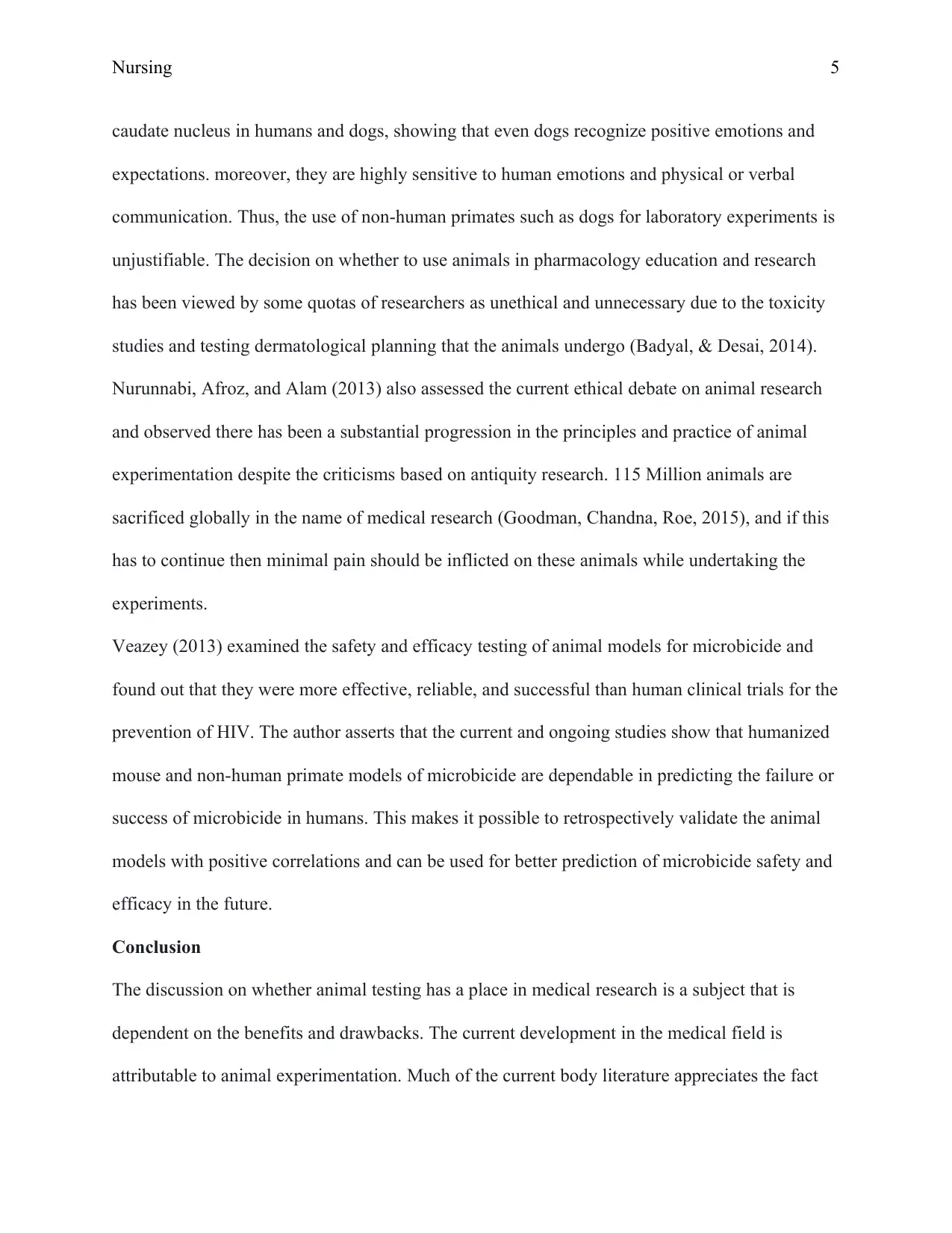
Nursing 5
caudate nucleus in humans and dogs, showing that even dogs recognize positive emotions and
expectations. moreover, they are highly sensitive to human emotions and physical or verbal
communication. Thus, the use of non-human primates such as dogs for laboratory experiments is
unjustifiable. The decision on whether to use animals in pharmacology education and research
has been viewed by some quotas of researchers as unethical and unnecessary due to the toxicity
studies and testing dermatological planning that the animals undergo (Badyal, & Desai, 2014).
Nurunnabi, Afroz, and Alam (2013) also assessed the current ethical debate on animal research
and observed there has been a substantial progression in the principles and practice of animal
experimentation despite the criticisms based on antiquity research. 115 Million animals are
sacrificed globally in the name of medical research (Goodman, Chandna, Roe, 2015), and if this
has to continue then minimal pain should be inflicted on these animals while undertaking the
experiments.
Veazey (2013) examined the safety and efficacy testing of animal models for microbicide and
found out that they were more effective, reliable, and successful than human clinical trials for the
prevention of HIV. The author asserts that the current and ongoing studies show that humanized
mouse and non-human primate models of microbicide are dependable in predicting the failure or
success of microbicide in humans. This makes it possible to retrospectively validate the animal
models with positive correlations and can be used for better prediction of microbicide safety and
efficacy in the future.
Conclusion
The discussion on whether animal testing has a place in medical research is a subject that is
dependent on the benefits and drawbacks. The current development in the medical field is
attributable to animal experimentation. Much of the current body literature appreciates the fact
caudate nucleus in humans and dogs, showing that even dogs recognize positive emotions and
expectations. moreover, they are highly sensitive to human emotions and physical or verbal
communication. Thus, the use of non-human primates such as dogs for laboratory experiments is
unjustifiable. The decision on whether to use animals in pharmacology education and research
has been viewed by some quotas of researchers as unethical and unnecessary due to the toxicity
studies and testing dermatological planning that the animals undergo (Badyal, & Desai, 2014).
Nurunnabi, Afroz, and Alam (2013) also assessed the current ethical debate on animal research
and observed there has been a substantial progression in the principles and practice of animal
experimentation despite the criticisms based on antiquity research. 115 Million animals are
sacrificed globally in the name of medical research (Goodman, Chandna, Roe, 2015), and if this
has to continue then minimal pain should be inflicted on these animals while undertaking the
experiments.
Veazey (2013) examined the safety and efficacy testing of animal models for microbicide and
found out that they were more effective, reliable, and successful than human clinical trials for the
prevention of HIV. The author asserts that the current and ongoing studies show that humanized
mouse and non-human primate models of microbicide are dependable in predicting the failure or
success of microbicide in humans. This makes it possible to retrospectively validate the animal
models with positive correlations and can be used for better prediction of microbicide safety and
efficacy in the future.
Conclusion
The discussion on whether animal testing has a place in medical research is a subject that is
dependent on the benefits and drawbacks. The current development in the medical field is
attributable to animal experimentation. Much of the current body literature appreciates the fact
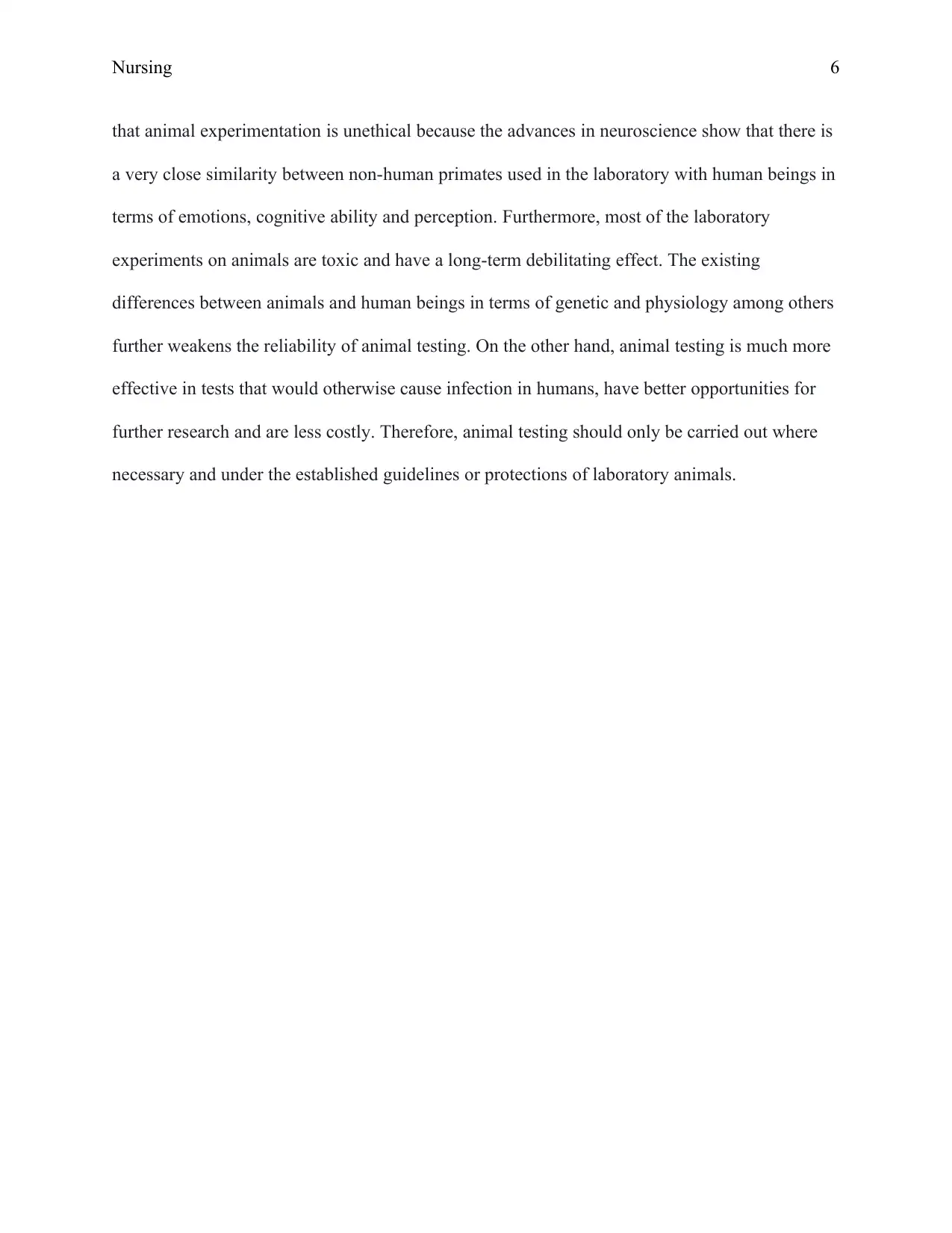
Nursing 6
that animal experimentation is unethical because the advances in neuroscience show that there is
a very close similarity between non-human primates used in the laboratory with human beings in
terms of emotions, cognitive ability and perception. Furthermore, most of the laboratory
experiments on animals are toxic and have a long-term debilitating effect. The existing
differences between animals and human beings in terms of genetic and physiology among others
further weakens the reliability of animal testing. On the other hand, animal testing is much more
effective in tests that would otherwise cause infection in humans, have better opportunities for
further research and are less costly. Therefore, animal testing should only be carried out where
necessary and under the established guidelines or protections of laboratory animals.
that animal experimentation is unethical because the advances in neuroscience show that there is
a very close similarity between non-human primates used in the laboratory with human beings in
terms of emotions, cognitive ability and perception. Furthermore, most of the laboratory
experiments on animals are toxic and have a long-term debilitating effect. The existing
differences between animals and human beings in terms of genetic and physiology among others
further weakens the reliability of animal testing. On the other hand, animal testing is much more
effective in tests that would otherwise cause infection in humans, have better opportunities for
further research and are less costly. Therefore, animal testing should only be carried out where
necessary and under the established guidelines or protections of laboratory animals.
⊘ This is a preview!⊘
Do you want full access?
Subscribe today to unlock all pages.

Trusted by 1+ million students worldwide
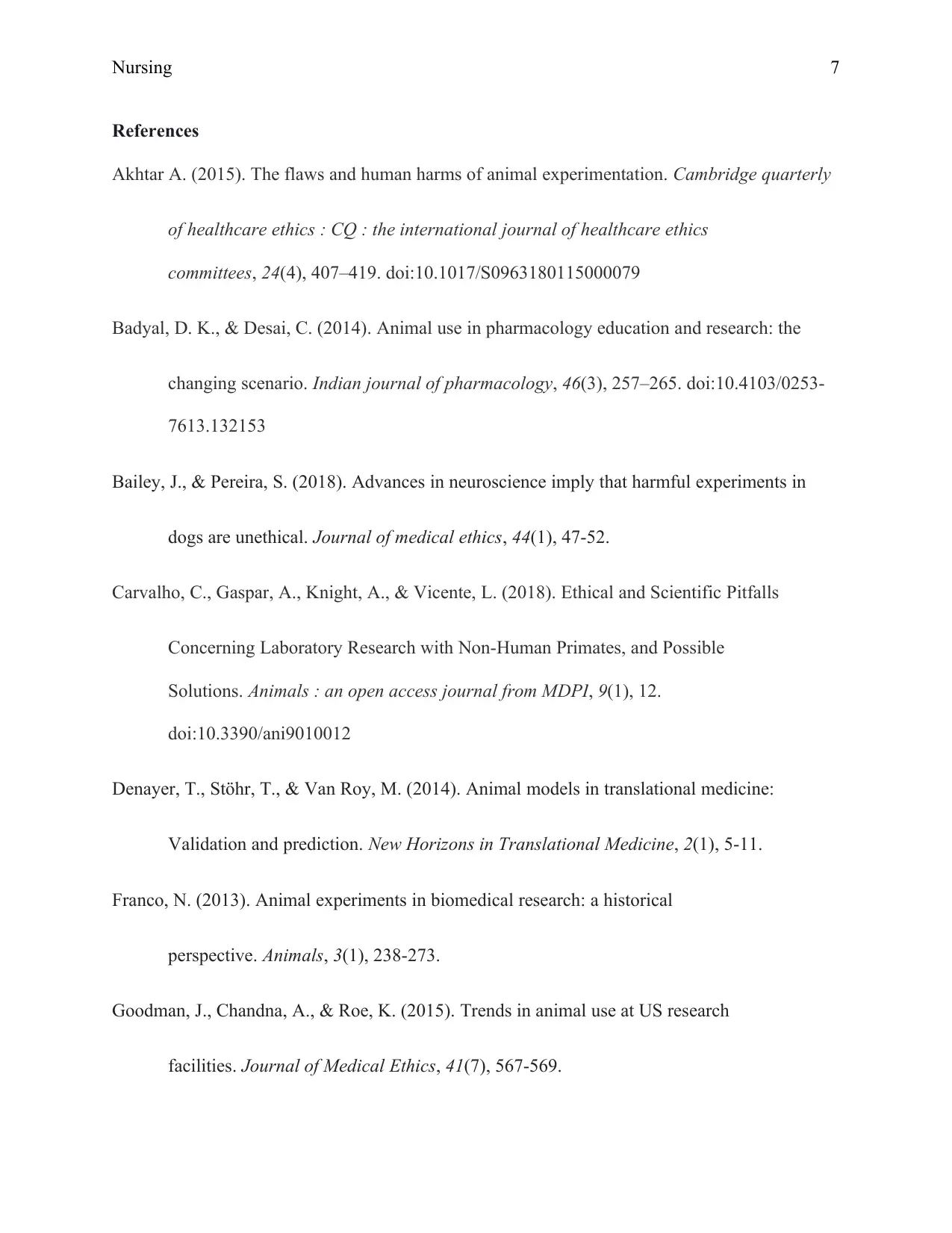
Nursing 7
References
Akhtar A. (2015). The flaws and human harms of animal experimentation. Cambridge quarterly
of healthcare ethics : CQ : the international journal of healthcare ethics
committees, 24(4), 407–419. doi:10.1017/S0963180115000079
Badyal, D. K., & Desai, C. (2014). Animal use in pharmacology education and research: the
changing scenario. Indian journal of pharmacology, 46(3), 257–265. doi:10.4103/0253-
7613.132153
Bailey, J., & Pereira, S. (2018). Advances in neuroscience imply that harmful experiments in
dogs are unethical. Journal of medical ethics, 44(1), 47-52.
Carvalho, C., Gaspar, A., Knight, A., & Vicente, L. (2018). Ethical and Scientific Pitfalls
Concerning Laboratory Research with Non-Human Primates, and Possible
Solutions. Animals : an open access journal from MDPI, 9(1), 12.
doi:10.3390/ani9010012
Denayer, T., Stöhr, T., & Van Roy, M. (2014). Animal models in translational medicine:
Validation and prediction. New Horizons in Translational Medicine, 2(1), 5-11.
Franco, N. (2013). Animal experiments in biomedical research: a historical
perspective. Animals, 3(1), 238-273.
Goodman, J., Chandna, A., & Roe, K. (2015). Trends in animal use at US research
facilities. Journal of Medical Ethics, 41(7), 567-569.
References
Akhtar A. (2015). The flaws and human harms of animal experimentation. Cambridge quarterly
of healthcare ethics : CQ : the international journal of healthcare ethics
committees, 24(4), 407–419. doi:10.1017/S0963180115000079
Badyal, D. K., & Desai, C. (2014). Animal use in pharmacology education and research: the
changing scenario. Indian journal of pharmacology, 46(3), 257–265. doi:10.4103/0253-
7613.132153
Bailey, J., & Pereira, S. (2018). Advances in neuroscience imply that harmful experiments in
dogs are unethical. Journal of medical ethics, 44(1), 47-52.
Carvalho, C., Gaspar, A., Knight, A., & Vicente, L. (2018). Ethical and Scientific Pitfalls
Concerning Laboratory Research with Non-Human Primates, and Possible
Solutions. Animals : an open access journal from MDPI, 9(1), 12.
doi:10.3390/ani9010012
Denayer, T., Stöhr, T., & Van Roy, M. (2014). Animal models in translational medicine:
Validation and prediction. New Horizons in Translational Medicine, 2(1), 5-11.
Franco, N. (2013). Animal experiments in biomedical research: a historical
perspective. Animals, 3(1), 238-273.
Goodman, J., Chandna, A., & Roe, K. (2015). Trends in animal use at US research
facilities. Journal of Medical Ethics, 41(7), 567-569.
Paraphrase This Document
Need a fresh take? Get an instant paraphrase of this document with our AI Paraphraser
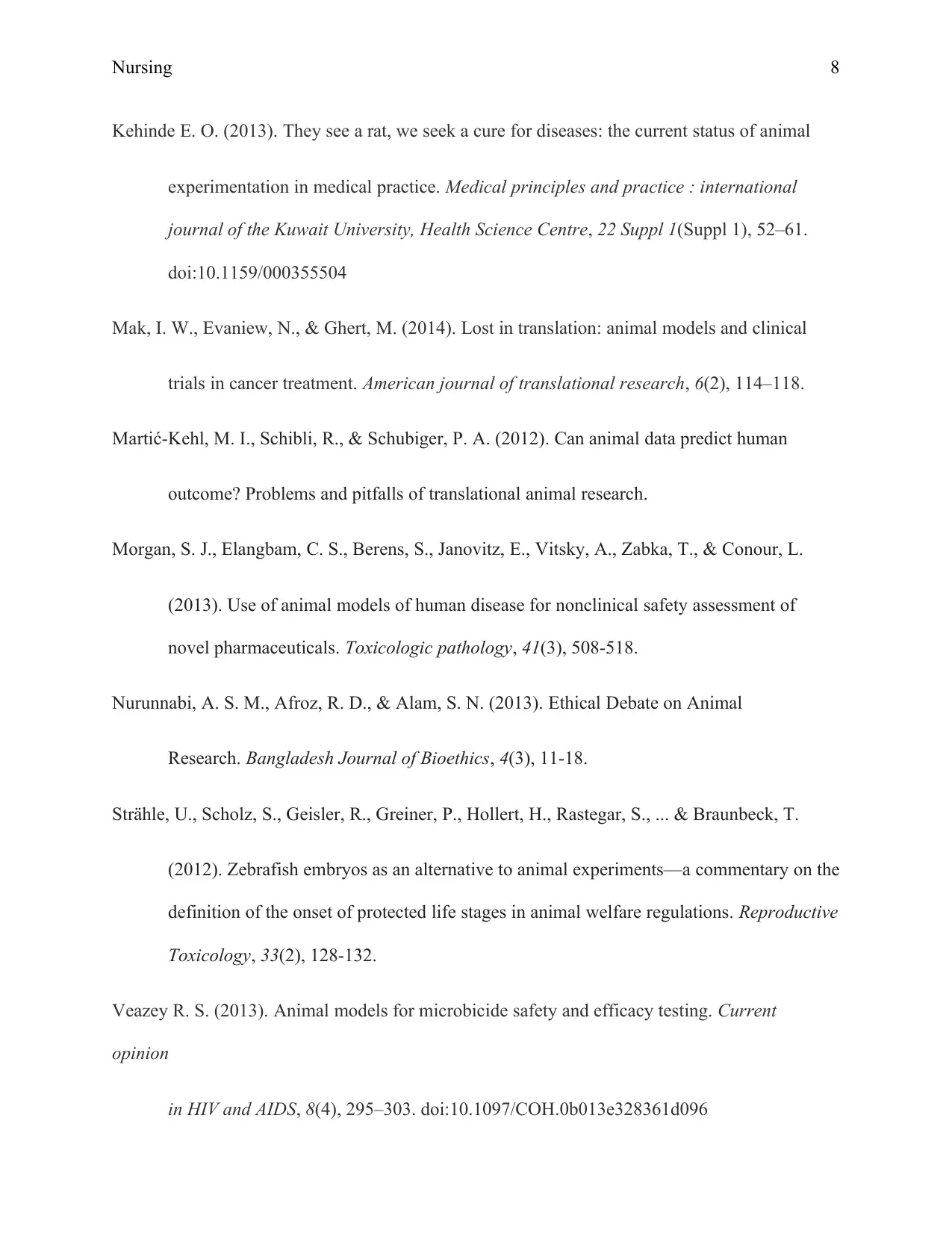
Nursing 8
Kehinde E. O. (2013). They see a rat, we seek a cure for diseases: the current status of animal
experimentation in medical practice. Medical principles and practice : international
journal of the Kuwait University, Health Science Centre, 22 Suppl 1(Suppl 1), 52–61.
doi:10.1159/000355504
Mak, I. W., Evaniew, N., & Ghert, M. (2014). Lost in translation: animal models and clinical
trials in cancer treatment. American journal of translational research, 6(2), 114–118.
Martić-Kehl, M. I., Schibli, R., & Schubiger, P. A. (2012). Can animal data predict human
outcome? Problems and pitfalls of translational animal research.
Morgan, S. J., Elangbam, C. S., Berens, S., Janovitz, E., Vitsky, A., Zabka, T., & Conour, L.
(2013). Use of animal models of human disease for nonclinical safety assessment of
novel pharmaceuticals. Toxicologic pathology, 41(3), 508-518.
Nurunnabi, A. S. M., Afroz, R. D., & Alam, S. N. (2013). Ethical Debate on Animal
Research. Bangladesh Journal of Bioethics, 4(3), 11-18.
Strähle, U., Scholz, S., Geisler, R., Greiner, P., Hollert, H., Rastegar, S., ... & Braunbeck, T.
(2012). Zebrafish embryos as an alternative to animal experiments—a commentary on the
definition of the onset of protected life stages in animal welfare regulations. Reproductive
Toxicology, 33(2), 128-132.
Veazey R. S. (2013). Animal models for microbicide safety and efficacy testing. Current
opinion
in HIV and AIDS, 8(4), 295–303. doi:10.1097/COH.0b013e328361d096
Kehinde E. O. (2013). They see a rat, we seek a cure for diseases: the current status of animal
experimentation in medical practice. Medical principles and practice : international
journal of the Kuwait University, Health Science Centre, 22 Suppl 1(Suppl 1), 52–61.
doi:10.1159/000355504
Mak, I. W., Evaniew, N., & Ghert, M. (2014). Lost in translation: animal models and clinical
trials in cancer treatment. American journal of translational research, 6(2), 114–118.
Martić-Kehl, M. I., Schibli, R., & Schubiger, P. A. (2012). Can animal data predict human
outcome? Problems and pitfalls of translational animal research.
Morgan, S. J., Elangbam, C. S., Berens, S., Janovitz, E., Vitsky, A., Zabka, T., & Conour, L.
(2013). Use of animal models of human disease for nonclinical safety assessment of
novel pharmaceuticals. Toxicologic pathology, 41(3), 508-518.
Nurunnabi, A. S. M., Afroz, R. D., & Alam, S. N. (2013). Ethical Debate on Animal
Research. Bangladesh Journal of Bioethics, 4(3), 11-18.
Strähle, U., Scholz, S., Geisler, R., Greiner, P., Hollert, H., Rastegar, S., ... & Braunbeck, T.
(2012). Zebrafish embryos as an alternative to animal experiments—a commentary on the
definition of the onset of protected life stages in animal welfare regulations. Reproductive
Toxicology, 33(2), 128-132.
Veazey R. S. (2013). Animal models for microbicide safety and efficacy testing. Current
opinion
in HIV and AIDS, 8(4), 295–303. doi:10.1097/COH.0b013e328361d096
1 out of 8
Your All-in-One AI-Powered Toolkit for Academic Success.
+13062052269
info@desklib.com
Available 24*7 on WhatsApp / Email
![[object Object]](/_next/static/media/star-bottom.7253800d.svg)
Unlock your academic potential
Copyright © 2020–2025 A2Z Services. All Rights Reserved. Developed and managed by ZUCOL.


